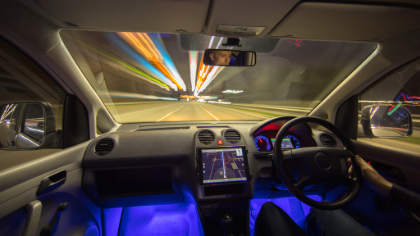INDEPENDENT DEALER
Mission, TX | (956) 458-9399
Oils RGV
OUR BLOG
07/08/2025
Dark roads, no problem! Get expert night driving safety tips to stay sharp, see better, and drive safer. Boost your skills with AMSOIL Dealer - Oils RGV in Mission, TX!

Let’s face it—driving at night is a whole different beast. The road feels lonelier, your eyes strain against the dark, and that sudden glare from oncoming headlights can leave you seeing spots. That’s why we’re breaking down the best night driving safety tips to help you navigate like a pro when the sun goes down. Ready to shine? Let’s hit the road!
Performance starts with protection. Call Oils RGV in Mission, TX, at (956) 458-9399 to find the AMSOIL products your vehicle deserves. Prefer online shopping? AMSOIL’s store is open 24/7 to meet your needs.
1. Why Night Driving is More Dangerous
Driving at night isn’t just a dimmer version of daytime driving—it’s a whole different experience. Your eyes have to work harder in the dark. Judging distance becomes tricky. Colors look dull. Peripheral vision shrinks. Headlight glare can be blinding. And as the hours go on, fatigue starts to set in.
There’s also a higher chance of running into impaired drivers, which makes staying alert even more important. The upside? With a few smart adjustments, you can drive safely and confidently—long after sunset.
2. Prepare Your Vehicle for Nighttime Safety
Your car’s your after-dark ally—so keep it sharp. Start with the basics: Are your headlights bright and aimed right? Dirty or misaligned lights are like squinting through the fog—useless. Pop the hood and check your synthetic oil, too—because a smooth engine means fewer surprise breakdowns in the middle of nowhere. And don’t forget the windshield. Wipe it down, inside and out. Streaks turn streetlights into a glare-filled disco. Not the fun kind.
3. Adjust Your Driving Habits for the Dark
Taking the wheel after dark requires extra caution. Follow these key driving practices to stay safe:
- Reduce your speed: It’s harder to see hazards in the dark, so driving slower gives you more time to spot and react to them.
- Increase the following distance: Leave more space between you and the car ahead—tailgating is especially dangerous at night.
- Avoid staring at oncoming headlights. Instead, glance toward the right edge of the road to maintain visibility.
- Use high beams responsibly: They improve visibility on dark roads but dim them when other cars approach to avoid blinding drivers.
Staying alert and adjusting your habits can make night driving much safer.
Looking for serious engine protection? AMSOIL Signature Series 0W-40 is your go-to synthetic motor oil. Call Oils RGV in Mission, TX, at (956) 458-9399 or explore AMSOIL’s online store to stock up on trusted car care solutions.
4. Stay Alert & Combat Fatigue
Your warm, cozy car plus darkness equals the ultimate sleep trap. If you're yawning, drifting in your lane, or missing turns, it's time to pull over. Your brain is running on empty. Take a 20–30 minute nap. Afterward, stretch your legs, drink some water, and grab a coffee if you can. A quick face splash helps, too. Even better? Switch drivers if someone else is with you. And skip the heavy fast food. A light snack keeps you sharper than a greasy burger ever will.
5. Protect Your Vision for Night Driving
If your night vision isn’t what it used to be, you’re not imagining it—our eyes naturally get worse at seeing in the dark as we age. An eye exam could reveal issues like cataracts, and anti-glare coatings on glasses can be a game-changer. Inside the car, dim your dashboard lights and avoid scrolling your phone—bright screens wreck your night vision faster than you’d think.
6. Be Extra Cautious
Deer, raccoons, and jaywalkers love making surprise appearances after sunset. Slow down in rural areas and stay extra alert in cities—pedestrians can pop out of nowhere. And if rain or fog joins the party? Dial your speed way back. Your tires and brakes better be in top shape because nighttime + bad weather = peak danger time.
7. Emergency Preparedness: Plan for the Worst
Murphy’s Law says if something can go wrong, it’ll happen at night. So stash a flashlight, flares, and jumper cables in your trunk (along with some synthetic oil for emergencies). Keep your phone charged, and know who to call if things go south. Because getting stranded in the dark? No thanks.
Conclusion: Drive Safe, Shine Bright
Night driving doesn’t have to be a white-knuckle experience. With a well-prepped car, smart adjustments to your driving, and some night driving safety tips in your back pocket, you can tackle the dark like a pro.
So go ahead—share these tips, schedule that oil change, and hit the road with confidence. The night is yours to conquer!
Ready to put our night driving safety tips into action? Start by protecting your engine with trusted AMSOIL products. For help choosing the right products, contact Oils RGV in Mission, TX, at (956) 458-9399. You can also shop at AMSOIL’s online store for quick and easy delivery.
CONTACT